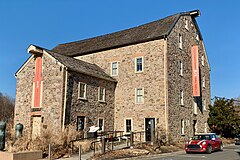Dunham's Mill
History
Daniel Hunt owned the land and a previous mill at this site during the American Revolution. After his death, his son Ralph owned the property. In 1828, Archibald Taylor bought the property and had J. W. Bray and his son John B. manage it. In 1834, the mill was sold to George W. Taylor and James R. Dunham. In 1836, the previous mill burned and the current mill was constructed by Charles and James R. Dunham. Operations started in 1837. Samuel Parry purchased the mill in 1843. The mill was used to grind wheat, rye, corn, and oats for flour and animal feed. By 1870, a small gypsum, or plaster, mill operation was added. After Parry's death in 1907, the mill was sold to Issac Krall, who operated it at full capacity during World War I. After Krall's death in 1929, the mill was sold to Joseph Kreidel, who would be the last operator. The mill remained in operation until 1952, when it was sold to become the home of the Hunterdon Art Museum.
Description
The mill is a 3+1⁄2-story stone building with a gambrel roof. The stone walls are between 18.5 and 23.75 inches (47.0 and 60.3 cm) thick. The original raceway went under a large brick archway on the west side of the building and exited to the south below the Clinton Dam. The main mill entrance and loading bays are located on the east side. A two-story stone plaster-mill building, built c. 1865, is attached to the south side of the main mill building.
Gallery
-
Gristmill, with plaster mill on the left, both with Hunterdon Art Museum banners
References
- ^ "National Register Information System – (#82003277)". National Register of Historic Places. National Park Service. November 2, 2013.
- ^ "National Register Information System – (#95001101)". National Register of Historic Places. National Park Service. November 2, 2013.
- ^ "New Jersey and National Registers of Historic Places – Hunterdon County" (PDF). New Jersey Department of Environmental Protection – Historic Preservation Office. December 28, 2020. p. 2.
- ^ Brash, Clarence; Lazarus, Diane Gail (October 1980). "National Register of Historic Places Inventory/Nomination: Dunham's Mill". National Park Service. With accompanying 13 photos
- ^ Brecknell, Ursula C. (August 1994). "National Register of Historic Places Inventory/Nomination: Clinton Historic District". National Park Service. With accompanying 39 photos
- ^ "The Story of the Stone Mill and the Hunterdon Art Museum". Hunterdon Art Museum.
- ^ Zimmer, William (October 20, 2002). "Art Review: How Clinton's Gristmill Grew Into a Museum". The New York Times.
The Hunterdon Museum of Art may not be the largest museum in the state, but it is the most charming and picturesque.
- ^ Snell, James P. (1881). "Clinton Village". History of Hunterdon and Somerset Counties, New Jersey. Everts & Peck. pp. 544–545.
External links
 Media related to Dunham's Mill (Clinton, New Jersey) at Wikimedia Commons
Media related to Dunham's Mill (Clinton, New Jersey) at Wikimedia Commons- "Dunham's Mill". The Historical Marker Database.

